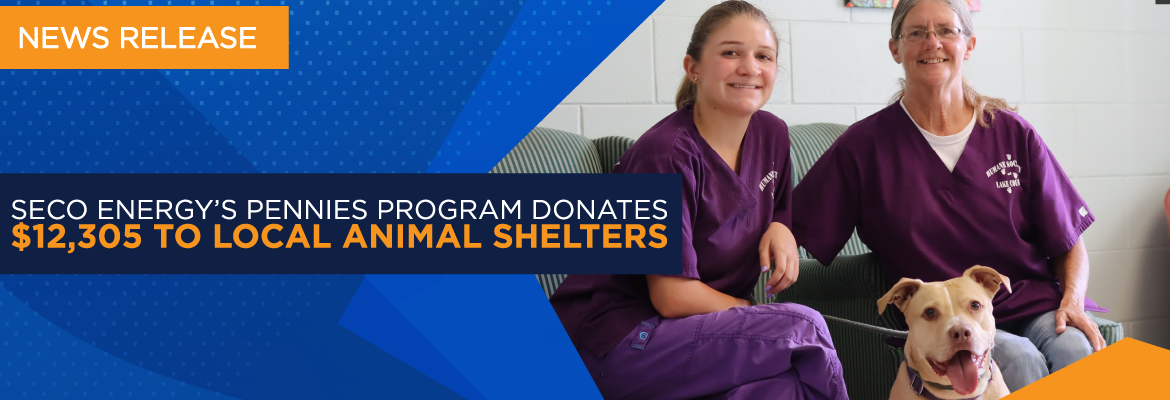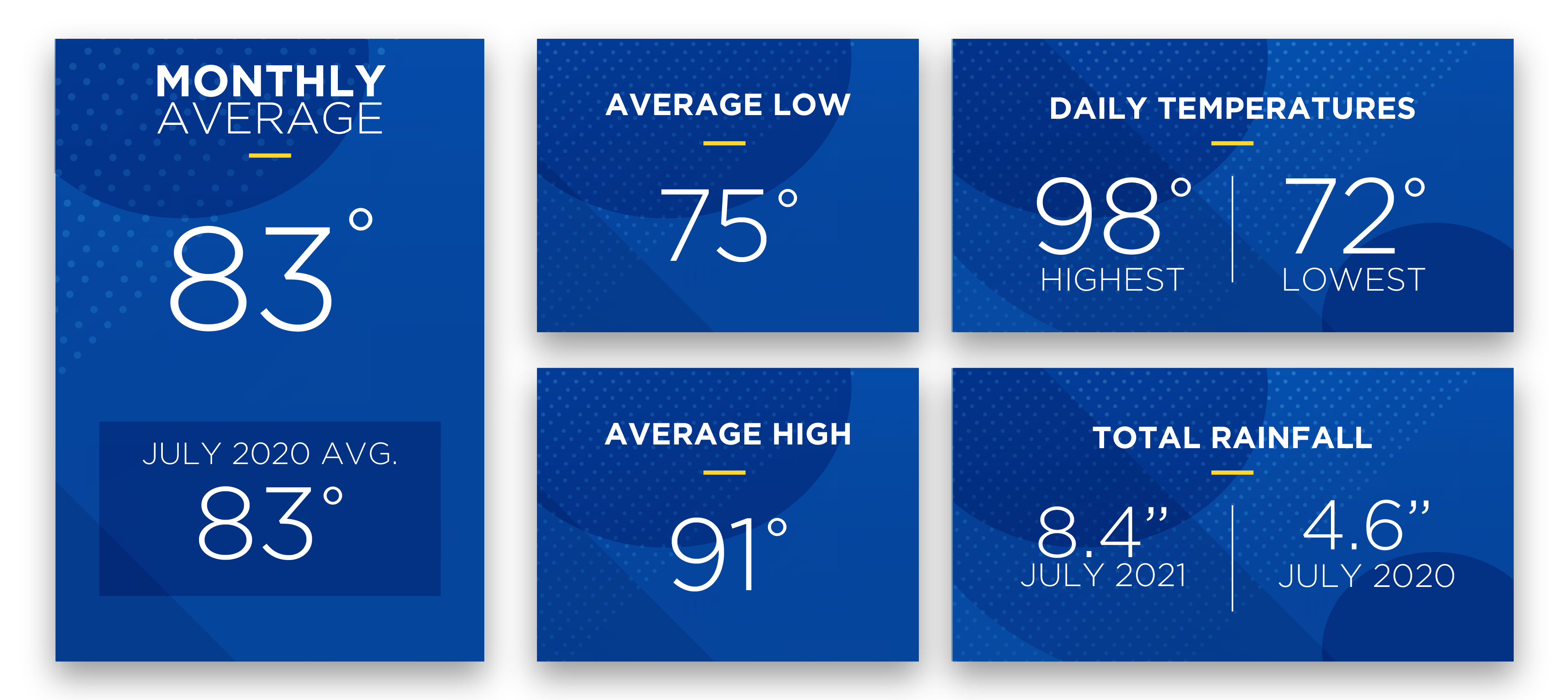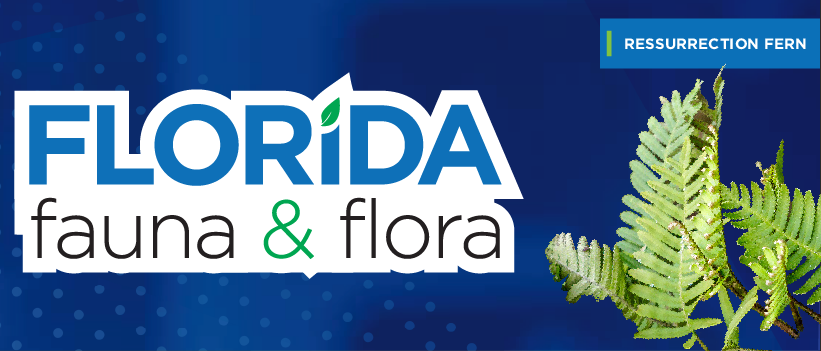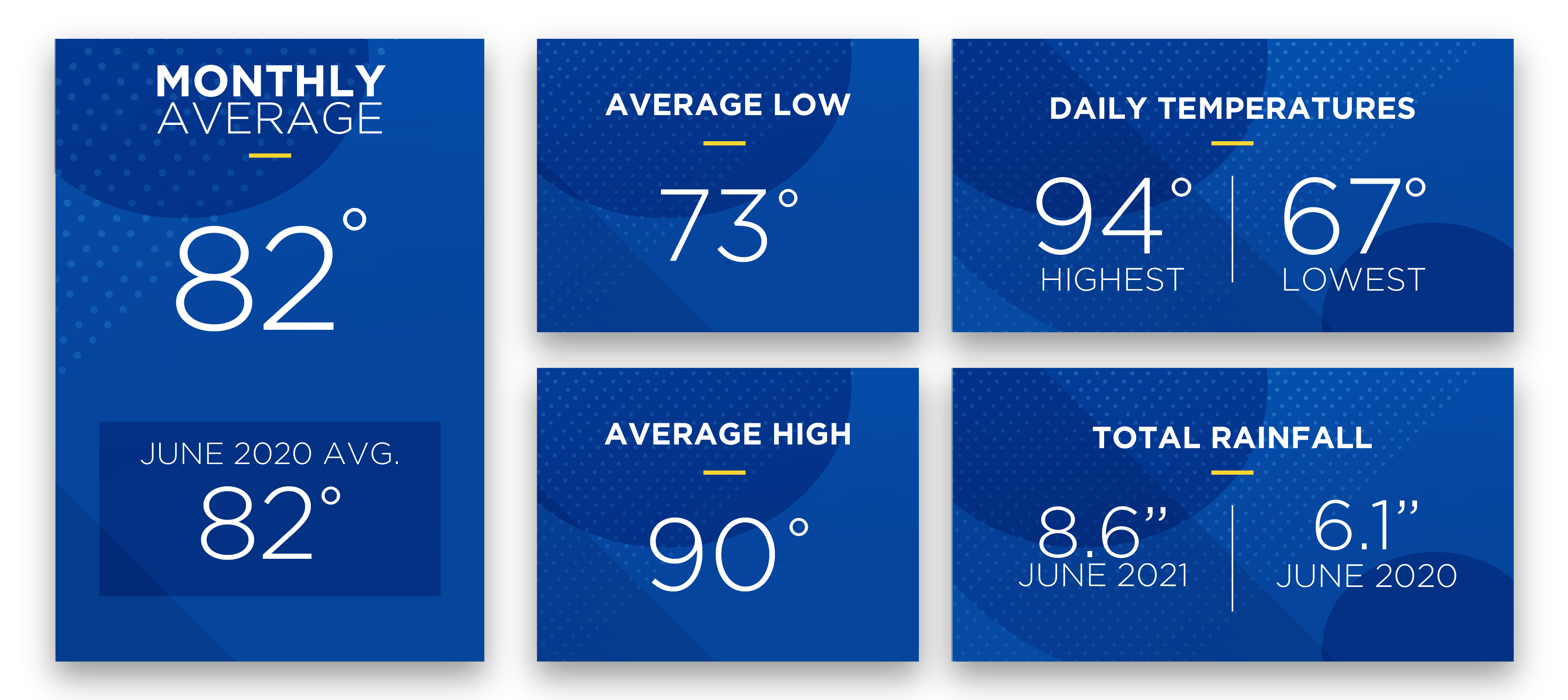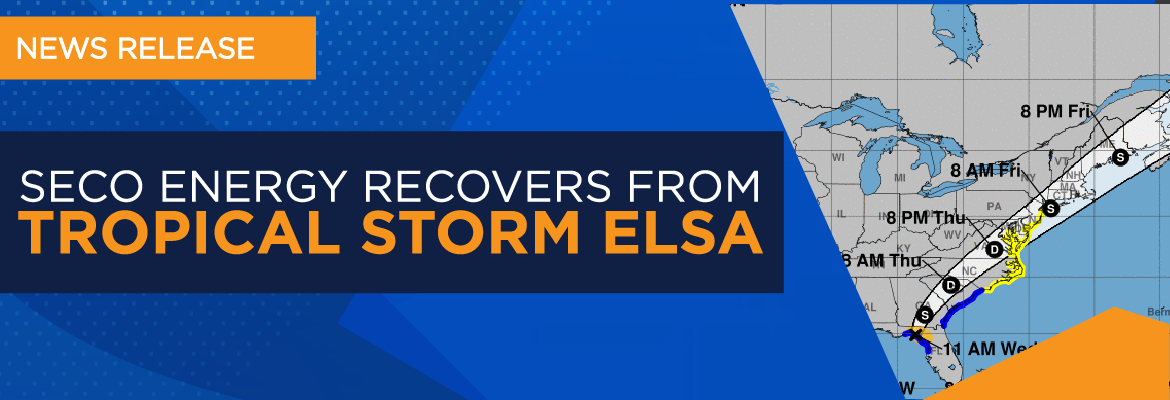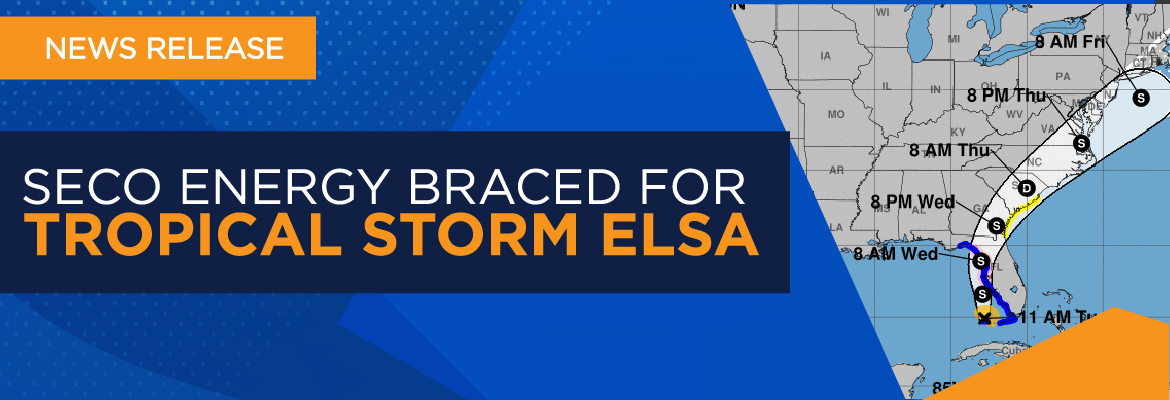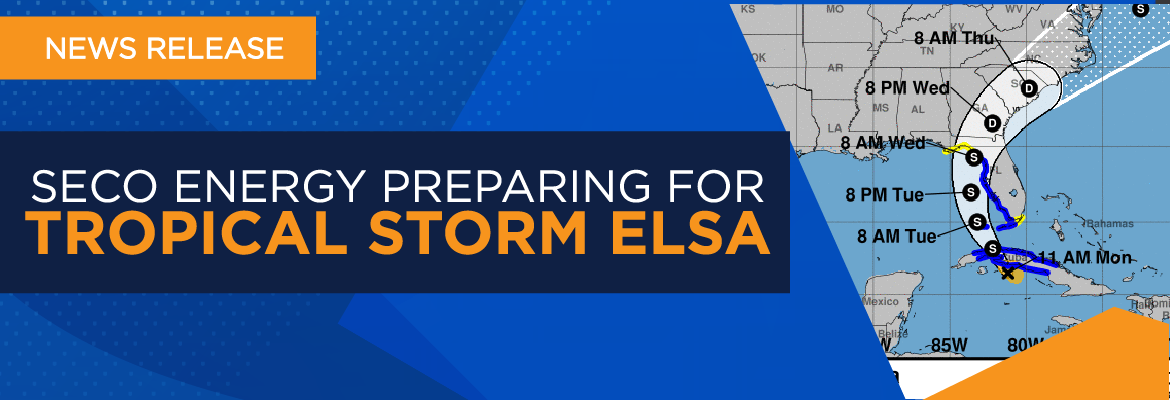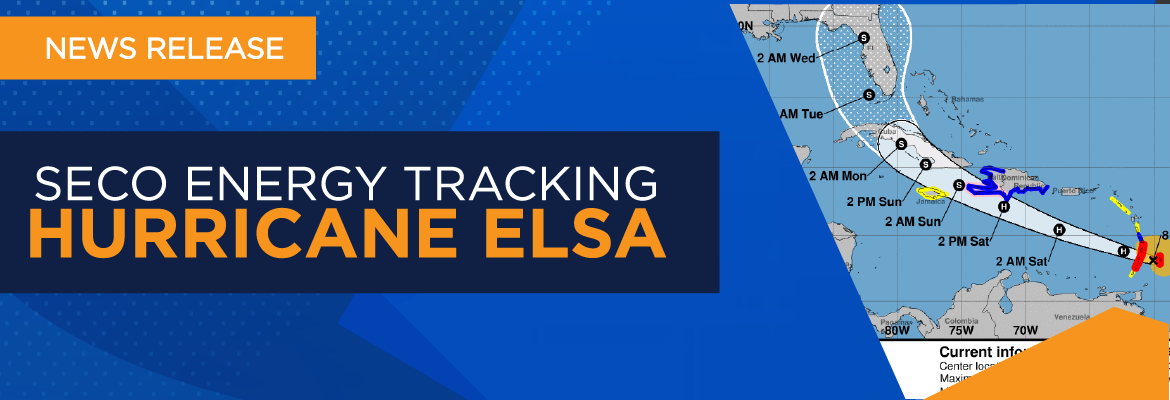Duncan’s Digest – Enroll in Surge Protection – Win a Generator
Dear Members,
The 2021 Atlantic hurricane season runs from June 1 to November 30. The Colorado State University (CSU) Tropical Meteorology Project team released an updated forecast for this year’s hurricane season. This team of experts has maintained its prediction that the Atlantic basin will have above-average storm activity this year, and has increased its forecast of the number of named storms anticipated this season.
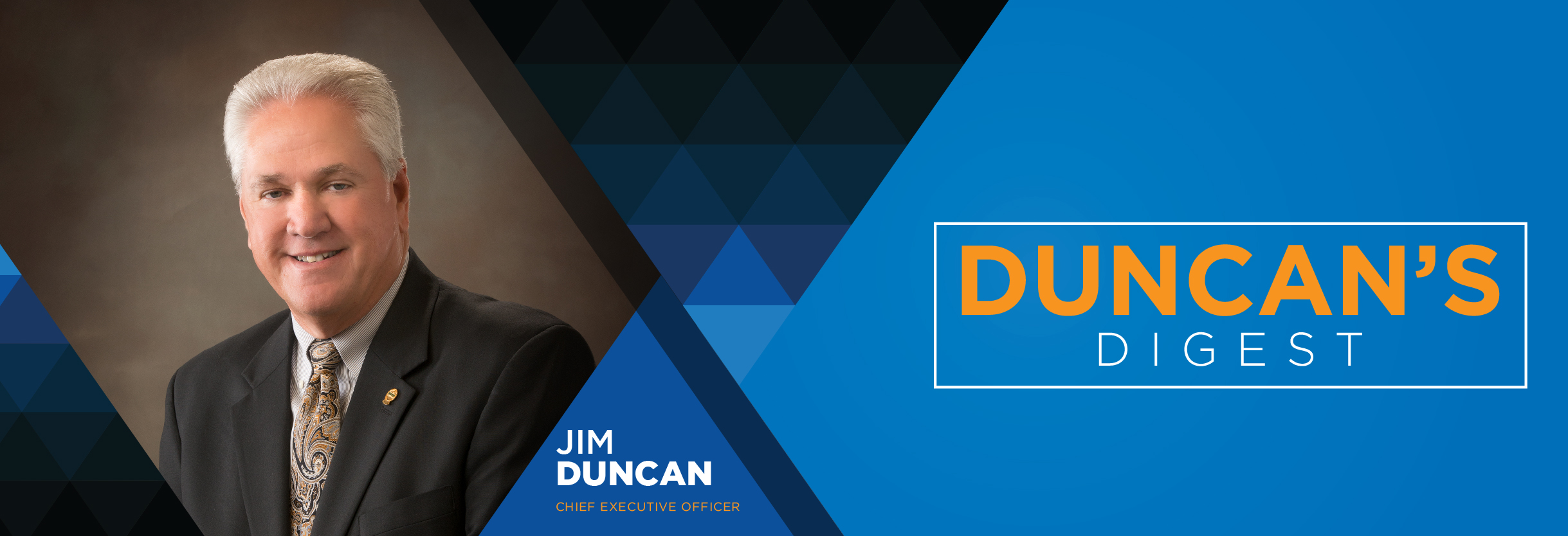
Tropical Storm Elsa affected our service area on Tuesday, July 6, and Wednesday, July 7. Elsa became the first named hurricane of the 2021 Atlantic hurricane season on July 2 when it reached Category 1 strength. Elsa was downgraded to a tropical storm as it passed over Cuba and the Florida Straits. For a short while, the storm lingered west of Tampa Bay and strengthened into a hurricane once again. Ultimately Elsa lost intensity and made landfall in Taylor County as a tropical storm on July 7.
SECO prepared for the worst. We brought in over 100 contract line and vegetation crews to assist in restoration from Tropical Storm Elsa. Overnight on the 6th and 7th, our system fared exceptionally well as Elsa’s rain bands soaked our service area and brought tornado watches, warnings and wind. During this time, we experienced no large substation or feeder outages. I commend our employees and contractors who rallied to assist in the effort by restoring outages quickly while working safely.
Tropical Storm Elsa was the first test of this year’s hurricane season, and we passed with flying colors. But it may be the first of many. That’s why it’s best to be prepared. Not only do we have hurricane season to contend with, but Florida has afternoon summer thunderstorms as well. These storms occur almost daily and bring heavy rain and lightning that can lead to power surges entering your home from the electric line and through the meter.
Surges are powerful increases in voltage that can destroy your home’s appliances and electronics. The Surge MitiGator is SECO’s meter-based surge arrester. It is designed to take the bite out of a surge. The MitiGator helps prevent high voltage spikes and surges before they damage appliances and cause financial loss. SECO installs the Surge MitiGator at the meter and the product carries a 15-year warranty. The arrester at the meter is the first step in protection. Point-of-use surge devices should be installed for a home’s electronics and other appliances that run on electric service. Purchase these at your local big box or hardware store. Install as directed.
The Surge MitiGator is available for lease for only $5.95 plus tax per month with a $25 installation fee. If you choose to purchase the product, the price ranges from $349 to $399, and installation is always free.
Enroll in the Surge MitiGator program (lease or purchase) for a chance to win a portable generator. We’ll pick a winner in both August and September. Read Winners’ Circle on page 4 for the July winner. Members in a current lease or prior purchase are already eligible to win. To enroll in the Surge MitiGator program, visit the Surge MitiGator page and fill out the web form. You can also call us at (352) 793-3801 or email Customer Service.
Living in Florida, the potential for tropical storms and hurricanes is a fact of life. I urge you to prepare in advance for the possibility of widespread power outages if a major storm affects our service area. Prepare your emergency supplies before forecasters put Central Florida in the cone of probability. Have a backup source of power if you require electricity for life-sustaining medical equipment. SECO is StormReady – you should be too.
Sincerely,
Jim Duncan
Chief Executive Officer

Advice from The Old Farmer’s Almanac
Florida, with its copious sunshine and sub-tropical climate, provides the perfect environment for a backyard garden. The Old Farmer’s Almanac has advice for gardeners who love the hobby but have space, sun or other limitations. For small areas, use raised beds, vertical spaces or containers. A raised-bed garden can yield 10 times the amount as a same size in-ground garden. Another idea for small spaces is to use a trellis, cage or attach pots to fences. Short on sun? Most vegetables require 8 hours of sunlight to grow, but leafy greens grow well in partial shade. Garlic, peas, beets and radishes can grow in as little as 4 hours a day. If all else fails, use containers to grow your garden. Anything that will hold soil and has water drainage holes will work.
Turn to page 4 to read this month’s Florida Fauna & Flora to learn more about the resurrection fern.

Energy Saving on a Budget
Improving your home’s energy efficiency doesn’t have to be expensive. While buying new ENERGY STAR appliances or upgrading your home’s HVAC will reduce your home’s energy consumption, these items carry a hefty price tag. The no-cost and low-cost energy-saving ideas listed below will help reduce your energy usage without breaking the bank.
No-cost Energy-Efficiency Ideas:
• Wash clothes in cold water.
• Use the air-dry cycle on your dishwasher.
• Hang laundry outside to dry.
• Use natural light during the day.
• Turn off lights when leaving a room.
• Ceiling fans cool people, not rooms. Turn off when the room is vacant.
• Turn off bathroom and kitchen ventilation fans. These bring warm outside air inside.
• Turn off electronics like computers, printers and monitors when not in use.
• In summer, grill or use appliances such as crock pots, air fryers or microwaves instead of your oven.
Low-cost Energy-Efficiency Ideas:
• Invest in LEDs.
• Replace all filters monthly or according to manufacturer’s instructions.
• Seal windows and doors with weatherstripping and/or caulk.
• Install window film to limit sunlight.
• Plant shade trees on the south, southwest and west sides of buildings for shade.
• Plant trees on the north and the west sides of buildings to block winds.
• Plant trees to shade driveways, sidewalks, patios and HVAC units.
• Use blinds or drapes during summer to limit sun exposure.
• Control outdoor lighting with a photocell or timer.
Want more energy-efficiency tips? Try our Home Energy Assessment — a complete online energy audit for your home. Submit your responses and email address to receive an email with energy-efficiency advice tailored to your home and lifestyle. To see the math behind your energy consumption, complete the Energy Estimator.

Winners’ Circle
Engage with our virtual assistant Electra on the phone for a chance to win a $25 gift card. Winners who self-served using Electra are:
John Bost from Ocala
Felica Grost from Inverness
Mark Damann from Morriston
Christian Oliver from Tavares
The latest winner of a SECO Energy Level 2 EV Charger is Marc Crail from Mount Dora. To enter, text “EV” to (352) 320-4500 for a link to enter. Or click on the EV Charger Giveaway homepage banner. Visit our Electric Vehicles website section to learn more about the benefits of owning an EV.
Winners in our Go Green and Win: Paperless Billing and Bank Draft Incentive
Kinilei Shewell from Clermont is the winner of a $200 SECO Energy bill credit.
Jules Sigler from Ocala is the winner of a NEST thermostat.
Jan Browning from The Villages is the winner of an Amazon Echo Dot with Alexa.
Bryant Currier from The Villages is our first winner of a portable generator. We have two more to give away! For a chance to win, lease or purchase SECO’s Surge MitiGator product that protects your home’s appliances from damaging surges and spikes. To learn more or enroll, visit our Surge MitiGator page. Members in a current surge lease or prior purchase are automatically entered in the drawing to win.
Read the full August 2021 SECO News online.



